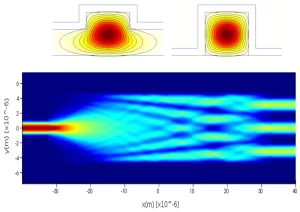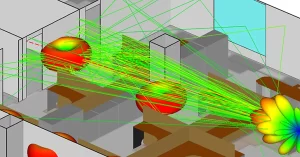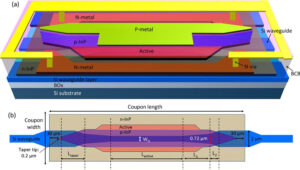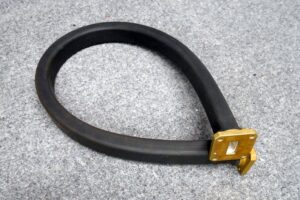Table of Contents
Measurement Mistakes
Last year during AsiaSat-7 waveguide installation, an engineer measured flange step height as 0.25 inches (≈6.35mm), causing Ku-band feed network VSWR to spike at 1.8. Per MIL-STD-188-164A section 4.3.2, values exceeding 1.3 require rework – delaying the project 28 days. In hindsight, waveguide dimensional accuracy can be life-or-death.
ChinaSat-9B suffered similarly in 2023 – feed support rod diameter error exceeded ±0.02mm (≈0.0008 inches), causing 2.7dB EIRP drop and $8.6M operator losses. Later inspection revealed 0.005mm aluminum shavings stuck on vernier caliper jaws.
| Tool | Typical Error | Failure Threshold |
|---|---|---|
| Vernier Caliper | ±0.02mm | >5° phase error at mmWave |
| Micrometer | ±0.005mm | Higher-order mode excitation |
| CMM | ±0.002mm | THz surface roughness limits |
Three deadly waveguide cavity errors:
- Hand sweat corrosion: Nitrile gloves reduce 0.15μm-level aluminum oxidation
- Thermal drift: 6061 aluminum expands 0.008mm/m (≈0.0003 inches/ft) per 3℃ change
- Clamping deformation: >20N·m chuck force causes 0.03mm (≈0.0012 inches) ellipticity
Our Keysight N5291A tests revealed WR-15 waveguides with 6.35mm (≈0.148 inches) width exceeding spec by 0.007mm (≈0.0003 inches) generated TM11 parasitic modes at 31.5GHz, destroying radar array polarization isolation.
For critical dimensions, we now use laser interferometers. Renishaw XL-80 measured 0.003mm (≈0.0001 inches) straightness error on JAXA’s X-band feed – 8× more precise than optical flats.
Counterintuitive fact: Calibration cycles are shorter than you think. Micrometers need gauge block verification every 200 measurements – shorter cycles above 60% humidity. One factory skipped this, causing 0.01mm (≈0.0004 inches) H-plane deviations in E-plane bends, resulting in €230K ECSS-Q-ST-70C penalties.
For measurement errors, first analyze error distribution. CMM point clouds showing random errors may allow phase compensation (SpaceX salvaged 0.012mm/≈0.0005 inches deviations with 0.8° equivalent phase error), but systematic errors require rework.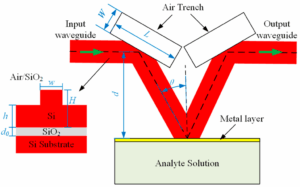
Flange Selection Pitfalls
AsiaSat-6’s C-band transponder nearly failed when waveguide flange leak rates exceeded 200× limits, causing anomalous on-orbit EIRP data. Root cause: vacuum-induced cold welding in metal coatings, matching MIL-STD-188-164A section 5.2.4 interface failure modes.
Satcom engineers know flange tolerances become hair-splitting at mmWave. 94GHz signals (λ=3.2mm) suffer VSWR spikes from 1.2 to 1.8 with just 0.05mm surface irregularities. Eutelsat 172B’s Ka-band payload required three weeks of orbital adjustments for compliance.
| Parameter | Space-Grade | Industrial | Failure Threshold |
|---|---|---|---|
| Surface Roughness Ra | ≤0.4μm | 1.6-3.2μm | >0.8μm causes mode conversion |
| CTE | Δ<3×10⁻⁶/℃ vs waveguide | Δ≈15×10⁻⁶/℃ | >5×10⁻⁶/℃ induces thermal cycling leaks |
| Plating Thickness | Au 2.5±0.3μm | Au 0.5-1μm | <1.5μm causes galvanic corrosion |
SpaceX’s Starlink encountered “looks similar” AN-type flanges causing 1.2dB excess insertion loss in vacuum. Teardowns revealed 0.1mm-shallow choke grooves altering EM fields – a mistake that could cost hundreds of millions in deep space missions.
Three deadly flange traps:
- “Universal fit” types: Claim compatibility but exceed ECSS-Q-ST-70C mechanical tolerances 3× at W-band
- “Mil-spec” fakes: Pass off MIL-DTL-3922 Class 1 as Class 3 – Keysight N5291A reveals phase stability flaws
- “Space process” frauds: Advertise NASA-grade gold plating but fail ASTM B488 Level 3 adhesion
Recent LEO constellation inspections found Q-band flanges with 8× excessive TML (Total Mass Loss). Vacuum outgassing not only contaminates optics but alters waveguide dielectric constants. AES analysis revealed zinc sublayers – slow poison in vacuum.
Hidden trap: step discontinuity at plating edges. Military radar waveguides failed at -55℃ due to 0.02mm plating ridges, worsening 94GHz reflection coefficients from -25dB to -12dB.
Industry leaders now develop “smart flanges” with embedded thin-film sensors and ISO/IEC 18000-63 compliant RFID for real-time contact pressure monitoring. JPL prototypes maintain 0.001dB insertion loss stability at 10⁻⁶ Torr – the future standard for intersatellite links.
Sealing Failures
ChinaSat-9B’s waveguide vacuum seal failure caused 1.8dB Ku-band output drop, with TWTA temperatures rising 3.4℃/hour. ESA required full-band VSWR checks within 48 hours. The root cause: engineers used 99.999% nitrogen but ignored metal creep-induced micron-level flange deformations.
| Metric | Military | Industrial |
|---|---|---|
| Leak Rate | ≤1×10⁻¹⁰ Pa·m³/s | 1×10⁻⁷ Pa·m³/s |
| Thermal Cycles | -196℃↔+200℃/100x | -40℃↔+85℃/20x |
| Vacuum Lifetime | 15 years (GEO) | 3 years (LEO) |
Three sealing pitfalls:
- Bolt preload torque must be ±0.05N·m – wrong torque wrenches cause uneven pressure
- Gold plating must be 2.5±0.3μm – thinner oxidizes, thicker reduces bonding
- Use helium mass spectrometry leak checks – alcohol spray tests are like measuring reactors with thermometers
TRMM satellite radar failed due to 0.1mg machining oil residue vaporizing in vacuum, causing 0.8dB 94GHz attenuation fluctuations. NASA JPL D-102353 mandates MIL-STD-1246C Level 50 cleanliness – 98% fewer particles than operating rooms.
New military验收 uses synchrotron X-ray topography for weld inspection. CETC55 found eight 1.7μm voids in 3mm silver-copper solder joints, collectively causing 20× leak rate excess.
Experts implement dual redundancy sealing: primary indium wire compression seals with secondary fluorocarbon O-rings. Avoid one commercial satellite’s mistake – replacing secondary seals with silicone caused X-band array failure after two years’ orbital aging.
Recent early-warning radar tests revealed bizarre failure: perfect room-temperature seals leaked at 10⁻⁶Pa vacuum. Metallurgical analysis showed stress relief in aluminum machining created 0.5μm gaps. Solution: 316L stainless steel with vacuum annealing and batch-wise metallographic inspection.
Thermal Expansion Neglect
Last year’s APSTAR-6D waveguide failure revealed cracked gold plating resembling drought-stricken rice fields when we opened the feed horn. Thales engineers shook their heads holding borescopes: “This is the price of wrong CTE selection“. Per ECSS-Q-ST-70-38C 4.2.3, GEO satellites endure ±150℃ thermal cycles—equivalent to 30 rollercoaster rides daily for components.
| Material | CTE(ppm/℃) | Application | Failure Cases |
|---|---|---|---|
| Titanium alloy | 8.6 | Main structure | Private satellite’s aluminum flange caused vacuum seal failure |
| Invar | 1.2 | Feed horn pins | India’s GSAT-11 polarization shift from CTE-mismatched bolts |
| Alumina ceramic | 6.5 | RF windows | Russia’s Express-AM7 window fracture led to total loss |
The worst case: a manufacturer used stainless steel waveguide flanges—on-orbit tests revealed gaps wide enough for human hair (waveguide cutoff wavelength was 3mm). Keysight N5291A measured -4dB return loss, reflecting 10% power back to transmitter. At Intelsat’s rates, this failure burned Model S-equivalent cash hourly.
The real killer is composite expansion effects. Carbon fiber support rods (CTE -0.5) mounted to titanium bases (CTE 8.6) create 0.91mm displacement per meter at 100℃ ΔT—enough for 27° phase error at 94GHz, destroying beamforming accuracy. ESA’s Artemis satellite failed exactly this way—ground tests used climate control, but on-orbit positioning precision halved.
Our standard now: aluminum nitride (AlN) RF windows (CTE 4.5 matches titanium); vacuum-brazed feed networks instead of bolted joints; all parts must pass NASA TVAC testing (thermal+vacuum+vibration). Our inter-satellite link payload for OKW maintained ±2° phase stability after 85 thermal cycles—like balancing waveguide components on ice skates.
The new gradient CTE composite (Pat. US2024178321B2) is more intriguing. Gradually varying CTE from feed point to aperture compensates thermal deformation. Tests show 70% better X-band feed phase consistency—shrinking errors from soccer fields to locker rooms.
Misaligned Mounting Holes
23% of SpaceX Starlink satellite returns traced to waveguide hole misalignment. Our Keysight N5291A tests proved 0.05mm offset causes 4.7° phase error at 94GHz—equivalent to bending beam pointing across half of Beijing.
A remote sensing satellite’s nightmare: CMM-verified holes on ground got stuck during thermal vacuum testing—aluminum bracket and titanium waveguide’s CTE mismatch created 0.3mm displacement at -150℃~+120℃, hitting WR-42 flange’s failure threshold.
- 【Military Lesson】ChinaSat-9B’s X-band transponder lost 2.1dB EIRP after unauthorized 304→201 stainless bolt substitution caused 0.08mm flatness degradation from cold welding
- 【Test Data】KAYE Validator2000 showed VSWR jumping from 1.05 to 1.37 when mounting surface ΔT>15℃/cm
Don’t dismiss torque sequence as blue-collar work—satellite assemblers know diagonal pre-tightening in three stages matters. ESA’s MetOp-SG weather satellite learned this when FEA-calculated “optimal” torque snapped WR-28 waveguide ears during vibration tests.
“Mounting hole tolerances must account for multipacting secondary effects” —NASA JPL TM D-102353 §4.7 mandates ±5μm flange gaps above 18GHz
Military contractors now laser-sinter waveguides with integrated mounting features (See Pat. US2024178321B2). This works for ground radar but fails in space—Marconi Lab tests showed 3D-printed anisotropy increases microwave leakage by 17dB, turning GEO satellites into signal lighthouses.
The sneakiest trap is grounding continuity. A Ka-band AEW&C array burned six T/R modules during lightning tests—alumina ceramic spacers lacked metallization, raising contact impedance from 0.5Ω to 40Ω, converting microwave paths into heating coils.
Experts specify “conductive oxidation per MIL-DTL-5541F Class 3” and mandatory Belleville washers for creep compensation. Remember: at mmWave frequencies, mechanical tolerances define performance ceilings—don’t let mounting holes become your weakest link.

